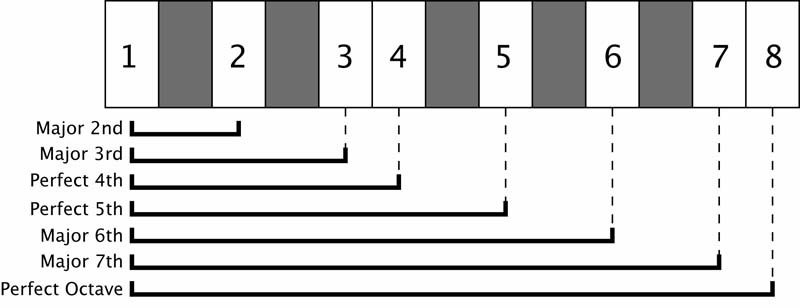Intervals
This tutorial will explain the concept of intervals, and describe how different intervals are named.
In music, we measure the distance from one note to the next using intervals. Intervals can be though of as musical “inches”.

The names of these intervals are derived from the Major Scale.
In order to understand intervals, you must also understand the Major Scale.
Unlike a ruler, where each unit is exactly the same size, the units that make up the major scale come in two different sizes.
The smaller unit, called a Half Step, represents the distance from one note to the nearest note next to it.
A Half Step is also known as a Semitone or a Minor 2nd.
The larger unit, called a Whole Step, or Major 2nd, is equal to two half steps.
The major scale is made of an unequal pattern of whole steps and half steps in this order:
Whole, Whole, Half, Whole, Whole, Whole, Half.
That is, 2 whole steps, 1 half step, 3 whole steps, 1 half step.


There is a key difference to keep in mind. In music, your starting point is considered “one”. On a ruler, your starting point is considered “zero”.
Intervals have not only a degree, that is how many scale steps they contain, they also have a quality.
4ths, 5ths, and octaves are generally called “Perfect” because they have a very pure sound.
All other intervals, namely 2nds, 3rds, 6ths, and 7ths, are called “Major” if they line up with the major scale.

In common speech they are sometimes called “flat”. For example, a “Flat Third”.
If a so called “Perfect” interval becomes flattened, we call it “Diminished”.

Intervals
Intervals
This tutorial will explain the concept of intervals, and describe how different intervals are named.
In music, we measure the distance from one note to the next using intervals. Intervals can be though of as musical “inches”.

The names of these intervals are derived from the Major Scale.
In order to understand intervals, you must also understand the Major Scale.
The smaller unit, called a Half Step, represents the distance from one note to the nearest note next to it.
A Half Step is also known as a Semitone or a Minor 2nd.
The larger unit, called a Whole Step, or Major 2nd, is equal to two half steps.
Whole, Whole, Half, Whole, Whole, Whole, Half.
That is, 2 whole steps, 1 half step, 3 whole steps, 1 half step.


There is a key difference to keep in mind. In music, your starting point is considered “one”. On a ruler, your starting point is considered “zero”.
4ths, 5ths, and octaves are generally called “Perfect” because they have a very pure sound.
All other intervals, namely 2nds, 3rds, 6ths, and 7ths, are called “Major” if they line up with the major scale.

In common speech they are sometimes called “flat”. For example, a “Flat Third”.
If a so called “Perfect” interval becomes flattened, we call it “Diminished”.
